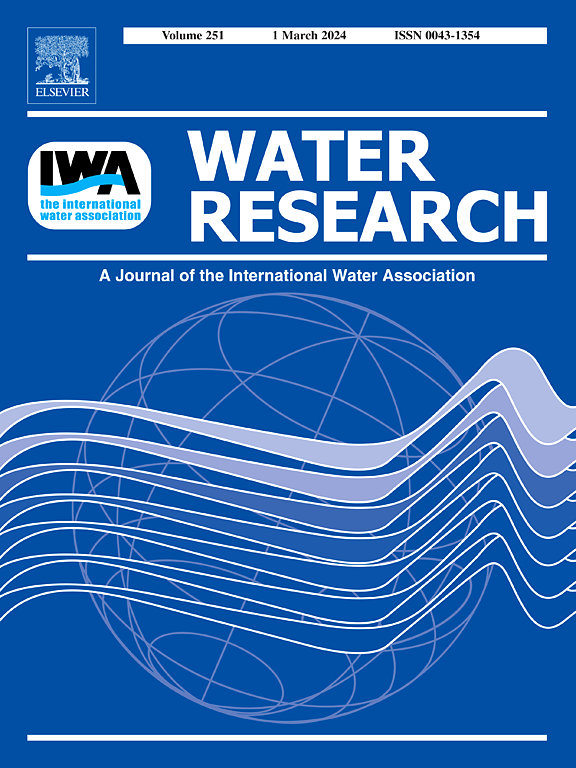氯化和氯化淡化水中卤代脂肪族和酚类消毒副产物的出现、毒性和控制问题
IF 11.4
1区 环境科学与生态学
Q1 ENGINEERING, ENVIRONMENTAL
引用次数: 0
摘要
海水淡化被广泛用于解决全球淡水短缺问题。然而,即使经过三级反渗透处理,淡化水仍含有 14.6 μg/L 脂肪族消毒副产物 (DBPs)、384.2 ng/L 溴酚类 DBPs、3.9 ng/L 碘酚类 DBPs、1024.7 μg/L Br-、2.8 μg/L I-和 2.4 mg C/L 溶解有机碳 (DOC)。用氯(胺)烷对淡化水消毒后,卤代脂肪族和酚类 DBPs 的浓度进一步增加,其中溴酚类 DBPs 是毒性诱发剂。当地表水与淡化水混合后再进行氯化处理时,脂肪族和酚类 DBPs 的产量显著增加。在将淡化水和地表水混合之前分别进行氯化处理可以缓解这种不利情况。与氯消毒相比,氯胺消毒更有利于降低经消毒的淡化水和混合水的总计算毒性。用颗粒活性炭处理淡化水可以有效去除 DOC 和 UV254,从而降低氯(胺)消毒后总有机卤素的含量。阴离子交换树脂虽然可以吸附硼氢化物,但同时也释放了 DBPs 的有机前体,最终增加了 DBPs 的产量。本研究的结果可为海水淡化行业提供参考,以改进海水预处理和海水淡化工艺,从而最大限度地减少 DBPs。本文章由计算机程序翻译,如有差异,请以英文原文为准。

Occurrence, toxicity, and control of halogenated aliphatic and phenolic disinfection byproducts in the chlorinated and chloraminated desalinated water
Seawater desalination is widely used to overcome the freshwater shortage worldwide. However, even after three-stage reverse osmosis treatment, the desalinated water still contained 14.6 μg/L of aliphatic disinfection byproducts (DBPs), 384.2 ng/L of bromophenolic DBPs, 3.9 ng/L of iodophenolic DBPs, 1024.7 μg/L of Br-, 2.8 μg/L of I-, and 2.4 mg C/L of dissolved organic carbon (DOC). After the desalinated water was disinfected with chlor(am)ine, the concentrations of halogenated aliphatic and phenolic DBPs further increased, and bromophenolic DBPs were the toxicity forcing agents. When surface water was mixed with desalinated water and then chlorinated, the yield of aliphatic and phenolic DBPs significantly elevated. Separately chlorinating desalinated water and surface water before mixing could mitigate this adverse situation. Chloramine disinfection was more conducive to reducing the total calculated toxicity of disinfected desalinated waters and mixed waters compared to chlorine disinfection. The treatment of desalinated water with granular activated carbon could effectively remove DOC and UV254, leading to a reduction in the content of total organic halogen after chlor(am)ination. Although anion exchange resin could adsorb Br-, it also released the organic precursors of DBPs, ultimately increasing the yield of DBPs. The results of this study can provide a reference for the seawater desalination industry to improve seawater pre-treatment and desalination processes and thus minimize the DBPs.
求助全文
通过发布文献求助,成功后即可免费获取论文全文。
去求助
来源期刊

Water Research
环境科学-工程:环境
CiteScore
20.80
自引率
9.40%
发文量
1307
审稿时长
38 days
期刊介绍:
Water Research, along with its open access companion journal Water Research X, serves as a platform for publishing original research papers covering various aspects of the science and technology related to the anthropogenic water cycle, water quality, and its management worldwide. The audience targeted by the journal comprises biologists, chemical engineers, chemists, civil engineers, environmental engineers, limnologists, and microbiologists. The scope of the journal include:
•Treatment processes for water and wastewaters (municipal, agricultural, industrial, and on-site treatment), including resource recovery and residuals management;
•Urban hydrology including sewer systems, stormwater management, and green infrastructure;
•Drinking water treatment and distribution;
•Potable and non-potable water reuse;
•Sanitation, public health, and risk assessment;
•Anaerobic digestion, solid and hazardous waste management, including source characterization and the effects and control of leachates and gaseous emissions;
•Contaminants (chemical, microbial, anthropogenic particles such as nanoparticles or microplastics) and related water quality sensing, monitoring, fate, and assessment;
•Anthropogenic impacts on inland, tidal, coastal and urban waters, focusing on surface and ground waters, and point and non-point sources of pollution;
•Environmental restoration, linked to surface water, groundwater and groundwater remediation;
•Analysis of the interfaces between sediments and water, and between water and atmosphere, focusing specifically on anthropogenic impacts;
•Mathematical modelling, systems analysis, machine learning, and beneficial use of big data related to the anthropogenic water cycle;
•Socio-economic, policy, and regulations studies.
 求助内容:
求助内容: 应助结果提醒方式:
应助结果提醒方式:


